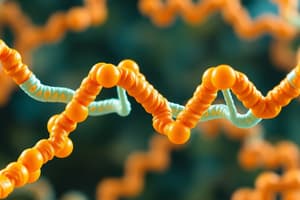Podcast
Questions and Answers
Which of the following is NOT a biologically important amino acid that does not enter the protein structure?
Which of the following is NOT a biologically important amino acid that does not enter the protein structure?
- Isoleucine (correct)
- Taurine
- Beta alanine
- Citrulline
Which type of peptide contains more than 10 amino acids?
Which type of peptide contains more than 10 amino acids?
- Poly peptide (correct)
- Dipeptide
- Tripeptide
- Oligopeptide
What is the isoelectric point (PI) of an amino acid?
What is the isoelectric point (PI) of an amino acid?
- The pH at which the amino acid carries positive and negative charges (correct)
- The point at which the amino acid becomes optically active
- The pH at which the amino acid becomes non-essential
- The point at which the amino acid forms a peptide bond
Which of the following is an example of a biologically active peptide?
Which of the following is an example of a biologically active peptide?
Which amino acid is optically inactive?
Which amino acid is optically inactive?
Which group is directly attached to the α carbon in each amino acid?
Which group is directly attached to the α carbon in each amino acid?
What is the classification of amino acids based on the number of carboxylic and amino groups?
What is the classification of amino acids based on the number of carboxylic and amino groups?
Which type of amino acids contains rings in their side chains?
Which type of amino acids contains rings in their side chains?
What is the classification of amino acids based on their nutritional needs?
What is the classification of amino acids based on their nutritional needs?
Which amino acid is classified as neutral and contains a sulfur atom in its side chain?
Which amino acid is classified as neutral and contains a sulfur atom in its side chain?
Which of the following amino acids must be taken with diet in growing infants and children?
Which of the following amino acids must be taken with diet in growing infants and children?
Which type of peptide contains less than 50 amino acids linked by peptide bonds?
Which type of peptide contains less than 50 amino acids linked by peptide bonds?
Which amino acid is a part of coenzyme A?
Which amino acid is a part of coenzyme A?
Which of the following is a biologically active peptide with analgesic effect more powerful than morphine?
Which of the following is a biologically active peptide with analgesic effect more powerful than morphine?
Which of the following statements about amino acids is true?
Which of the following statements about amino acids is true?
Which type of amino acids contains rings in their side chains?
Which type of amino acids contains rings in their side chains?
Which amino acid is classified as acidic and contains two carboxylic groups?
Which amino acid is classified as acidic and contains two carboxylic groups?
Which type of amino acids are optically active, except for glycine?
Which type of amino acids are optically active, except for glycine?
What is the classification of amino acids based on their nutritional needs?
What is the classification of amino acids based on their nutritional needs?
Which group is directly attached to the α carbon in each amino acid?
Which group is directly attached to the α carbon in each amino acid?
Study Notes
Amino Acids and Peptides
- Ornithine is a biologically important amino acid that does not enter the protein structure.
- Polypeptides contain more than 10 amino acids.
- The isoelectric point (pI) of an amino acid is the pH at which the amino acid has no net charge.
- Enkephalin is an example of a biologically active peptide.
- Glycine is the only optically inactive amino acid.
- The amino group (-NH2) and the carboxyl group (-COOH) are directly attached to the α carbon in each amino acid.
- Amino acids can be classified into three categories based on the number of carboxylic and amino groups: monoamino monocarboxylic acids, monoamino dicarboxylic acids, and diamino monocarboxylic acids.
- Aromatic amino acids contain rings in their side chains.
- Amino acids can be classified into two categories based on their nutritional needs: essential amino acids and non-essential amino acids.
- Methionine is a neutral amino acid that contains a sulfur atom in its side chain.
- Arginine and histidine are amino acids that must be taken with diet in growing infants and children.
- Peptides contain less than 50 amino acids linked by peptide bonds.
- Pantothenic acid is a part of coenzyme A.
- Beta-endorphin is a biologically active peptide with analgesic effect more powerful than morphine.
- Amino acids can be classified into acidic, basic, and neutral amino acids based on the pH of their side chains.
- Aromatic amino acids contain rings in their side chains.
- Aspartic acid and glutamic acid are classified as acidic and contain two carboxylic groups.
- All amino acids are optically active, except for glycine.
- Amino acids can be classified into two categories based on their nutritional needs: essential amino acids and non-essential amino acids.
- The amino group (-NH2) and the carboxyl group (-COOH) are directly attached to the α carbon in each amino acid.
Studying That Suits You
Use AI to generate personalized quizzes and flashcards to suit your learning preferences.
Description
Test your knowledge of the structure and properties of amino acids. This quiz covers the basic characteristics of amino acids, including the arrangement of functional groups and their optical activity.




